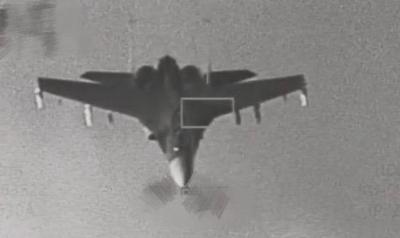More information about a new airbase in China’s Fujian Province emerged over the weekend, with military intelligence sources saying the base appeared to be designed to bolster China’s claim to sovereignty over islets in the East China Sea.
Military sources said construction at Shuimen air base, located on a hilltop along the coast in Shuimen Township, was nearing completion. Satellite images of the airbase first emerged in 2009, with intelligence sources saying China had cleared a swathe of more than 2km at an altitude of 364m to make way for the airbase, the Chinese-language United Evening News reported over the weekend.
More recent satellite imagery of the area showed J-10 multirole combat aircraft from the People’s Liberation Army Air Force (PLAAF) deployed at the base, with Russian-made Sukhoi Su-30 fighters and unmanned aerial vehicles (UAV) being gradually introduced.
S-300 long-range surface-to-air missile (SAM) batteries have also been spotted at the base, the report said. These could be part of the two battalions, or eight batteries, of more advanced S-300PMU1 systems ordered from Russia in 2001, a US$400 million deal that included 32 transporter erector launchers (TEL) and a total of 198 missiles. The missile batteries could also be HQ-9s, a Chinese derivative of the S-300.
The base is situated 246km from Taipei and 380km from the Diaoyutai Islands (釣魚台), over which Taiwan, China and Japan claim sovereignty.
With an engagement range of up to 200km, the S-300PMU1 could threaten aircraft in or near Taiwan’s airspace while also providing protection to the airbase from approaching aircraft and ballistic targets.
The Taiwanese military said it was aware of the new airbase and had the situation under control.
Long-range early-warning systems on Taiwan proper, as well as air defense radar deployed on Dongyin Island (東引島), one of the small islands that make up the Matsu chain and where the Taiwanese military has deployed Tien Kung II SAMs, are capable of tracking aircraft at the base, military sources said.
Dongyin is about 70km from the airbase.
Military sources said aircraft taking off from Shuimen could reach the Diaoyutais within 12 minutes, improving China’s response time for various contingencies in the East China Sea, most especially over the contested islets and the Chunxiao oil fields (春曉氣田), which are also the object of a dispute between the three countries.
In related developments, China’s first aircraft carrier, the refurbished Varyag, embarked on its seventh sea trial in the Bohai Sea on Wednesday and is expected to conduct various tests at sea before returning to Dalian on Saturday. Chinese military officials have said the Varyag will enter service later this year.
Also last week, the People’s Liberation Army Navy (PLAN) launched the first new Type 056 class missile corvette, with three others expected to be launched soon.
According to military analysts, the 1,400-1,700-tonne vessels will be introduced into the PLAN’s South China Fleet to strengthen China’s claims on disputed areas with Taiwan, the Philippines and Vietnam.

Trips for more than 100,000 international and domestic air travelers could be disrupted as China launches a military exercise around Taiwan today, Taiwan’s Civil Aviation Administration (CAA) said yesterday. The exercise could affect nearly 900 flights scheduled to enter the Taipei Flight Information Region (FIR) during the exercise window, it added. A notice issued by the Chinese Civil Aviation Administration showed there would be seven temporary zones around the Taiwan Strait which would be used for live-fire exercises, lasting from 8am to 6pm today. All aircraft are prohibited from entering during exercise, it says. Taipei FIR has 14 international air routes and

Taiwan lacks effective and cost-efficient armaments to intercept rockets, making the planned “T-Dome” interception system necessary, two experts said on Tuesday. The concerns were raised after China’s military fired two waves of rockets during live-fire drills around Taiwan on Tuesday, part of two-day exercises code-named “Justice Mission 2025.” The first wave involved 17 rockets launched at 9am from Pingtan in China’s Fujian Province, according to Lieutenant General Hsieh Jih-sheng (謝日升) of the Office of the Deputy Chief of the General Staff for Intelligence at the Ministry of National Defense. Those rockets landed 70 nautical miles (129.6km) northeast of Keelung without flying over Taiwan,

City buses in Taipei and New Taipei City, as well as the Taipei MRT, would on Saturday begin accepting QR code payments from five electronic payment providers, the Taipei Department of Transportation said yesterday. The new option would allow passengers to use the “transportation QR code” feature from EasyWallet, iPass Money, iCash Pay, Jkopay or PXPay Plus. Passengers should open their preferred electronic payment app, select the “transportation code” — not the regular payment code — unlock it, and scan the code at ticket readers or gates, General Planning Division Director-General Liu Kuo-chu (劉國著) said. People should move through the

The Ministry of National Defense (MND) today released images of the military tracking China’s People's Liberation Army (PLA) movements during the latest round of Chinese drills around Taiwan. The PLA began "Justice Mission 2025" drills today, carrying out live-fire drills, simulated strikes on land and maritime targets, and exercises to blockade the nation's main ports. The exercises are to continue tomorrow, with the PLA announcing sea and air space restrictions for five zones around Taiwan for 10 hours starting from 8:30am. The ministry today released images showing a Chinese J-16 fighter jet tracked by a F-16V Block 20 jet and the